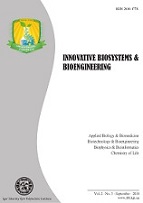Biodegrading Properties of the Microbiocenosis of Iron and Manganese Removal Rapid Filters for Groundwater
DOI:
https://doi.org/10.20535/ibb.2020.4.2.204919Keywords:
Iron removal, Rapid filters, Microbiocenosis of rapid filter bed, SynergismAbstract
Background. Determining the composition of the microbiocenosis of iron and manganese removal filters aims to expand the idea of its properties and interactions between its components, which is relevant for finding new filter beds, as well as for choosing combinations of microbiocenosis and optimal filter bed.
Objective. The aim of the work is to study the species composition of the microbiocenosis of rapid filters of iron and manganese removal and to establish the cause of the biodegradable properties of the microbiocenosis of rapid filters.
Methods. The study was performed using the iron and manganese removal filter bed from a pilot well in Khoroshiv, Zhytomyr region. The source water characterizes by high iron (15–25 mg/l) and manganese (2.0–2.3 mg/l) content. To identify microorganisms, cultures were performed on nutrient media.
Results. At the time of the experiment on the 10, 20 and 25th days of the filter cycle in the microbiocenosis about a third were iron- and manganese-oxidizing bacteria. The efficiency of iron removal was quite high and ranged from 87–97%. For manganese, the removal efficiency ranged from 83 to 89%. Pseudomonas bacteria were found in the microbiocenosis and it was determined that they are responsible for enhancing the biodegradable properties of the microbiocenosis due to synergistic interactions with iron- and manganese-oxidizing bacteria.
Conclusions. It has been established that Pseudomonas bacteria must be present in the microbiocenosis for the effective iron and manganese removal process. Pseudomonas bacteria give microbiocenosis biodegradable properties due to synergism.
References
National report on the quality of drinking water and the state of drinking water supply in Ukraine in 2018. Kyiv; 2019. Available from: https://mtu.gov.ua/files/%D0%9D%D0%B0%D1%86%D1%96%D0%BE%D0%BD%D0%B0%D0%BB%D1%8C%D0%BD%D0%B0%20%D0%B4%D0%BE%D0%BF%D0%BE%D0%B2%D1%96%D0%B4m_%202018.pdf.
Zeng H, Yin C, Zhang J, Li D. Start-Up of a Biofilter in a Full-Scale Groundwater Treatment Plant for Iron and Manganese Removal. International Journal of Environmental Research and Public Health. 2019;16(5):698. DOI: 10.3390/ijerph16050698
Kravchenko O. The role of microorganisms in the removal of high concentrations of iron from water on filters with zeolite loading. In: Actual problems of heat and gas supply and ventilation, water supply and drainage systems. Rivne: NUVHP; 2015, pp. 102-3.
Kravchenko O. Biocenoses in the loads of iron and manganese removal filters and the methods of settling them in zeolite. Eastern-European Journal of Enterprise Technologies. 2015;5(6(77):39-43. DOI: 10.15587/1729-4061.2015.51056
Kravchenko AV, Chernova NN, Panchenko ES, Kosygina NM, Yakupova IV. Role of microorganisms in water purification of compounds of iron and manganese in a dense layer of sorbent–catalyst. Journal of Water Chemistry and Technology. 2016;38(5):294-300. DOI: 10.3103/S1063455X16050088
Krieg NR, Staley JT, Brown DR, Hedlund BP, Paster BJ, Ward NL (eds.), et al. Bergey’s Manual of Systematic Bacteriology. Volume 4: The Bacteroidetes, Spirochaetes, Tenericutes (Mollicutes), Acidobacteria, Fibrobacteres, Fusobacteria, Dictyoglomi, Gemmatimonadetes, Lentisphaerae, Verrucomicrobia, Chlamydiae, and Planctomycetes. New York, NY: Springer New York; 2010, 949 p. DOI: 10.1007/978-0-387-68572-4
Banh A, Chavez V, Doi J, Nguyen A, Hernandez S, Ha V, et al. Manganese (Mn) Oxidation Increases Intracellular Mn in Pseudomonas putida GB-1. PLoS One. 2013;8(10):e77835. DOI: 10.1371/journal.pone.0077835
Parker DL, Lee S-W, Geszvain K, Davis RE, Gruffaz C, Meyer J-M, et al. Pyoverdine synthesis by the Mn(II)-oxidizing bacterium Pseudomonas putida GB-1. Frontiers in Microbiology. 2014;5:202. DOI: 10.3389/fmicb.2014.00202
Geszvain K, Smesrud L, Tebo BM. Identification of a Third Mn(II) Oxidase Enzyme in Pseudomonas putida GB-1. Applied and Environmental Microbiology. 2016;82(13):3774-82. DOI: 10.1128/AEM.00046-16
Emerson D, Fleming EJ, McBeth JM. Iron-Oxidizing Bacteria: An Environmental and Genomic Perspective. Annual Review of Microbiology. 2010;64:561-83. DOI: 10.1146/annurev.micro.112408.134208
Piazza A, Ciancio Casalini L, Pacini VA, Sanguinetti G, Ottado J, Gottig N. Environmental Bacteria Involved in Manganese(II) Oxidation and Removal From Groundwater. Frontiers in Microbiology. 2019;10:119. DOI: 10.3389/fmicb.2019.00119
Downloads
Published
How to Cite
Issue
Section
License
Copyright (c) 2020 The Author(s)

This work is licensed under a Creative Commons Attribution 4.0 International License.
The ownership of copyright remains with the Authors.
Authors may use their own material in other publications provided that the Journal is acknowledged as the original place of publication and National Technical University of Ukraine “Igor Sikorsky Kyiv Polytechnic Institute” as the Publisher.
Authors are reminded that it is their responsibility to comply with copyright laws. It is essential to ensure that no part of the text or illustrations have appeared or are due to appear in other publications, without prior permission from the copyright holder.
IBB articles are published under Creative Commons licence:- Authors retain copyright and grant the journal right of first publication with the work simultaneously licensed under CC BY 4.0 that allows others to share the work with an acknowledgement of the work's authorship and initial publication in this journal.
- Authors are able to enter into separate, additional contractual arrangements for the non-exclusive distribution of the journal's published version of the work (e.g., post it to an institutional repository or publish it in a book), with an acknowledgement of its initial publication in this journal.
- Authors are permitted and encouraged to post their work online (e.g., in institutional repositories or on their website) prior to and during the submission process, as it can lead to productive exchanges, as well as earlier and greater citation of published work.









